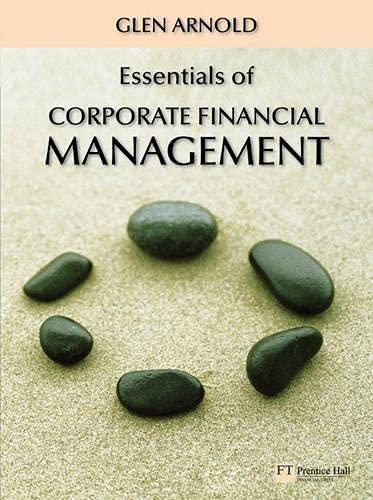b. Calculate the price of each of the three bonds. Round your answers to the nearest cent. Price (Bond A) : $ Price (Bond B): $ Price (Bond C):s c. Calculate the current yield for each of the three bonds. (Hint: The expected current yield is calculated as the annual interest divided by the price of the bond.) Round your answers to two decimal places. Currenk yield (Bond A): as Current yield (Bond B): Current vied (Bond C): d. If the vield to maturty for each bond remains at 10%, what will be the price of each bond 1 year from now? Round your answers to the nearest eent. Price (Bond A): 5 Price (bond b) 5 Price (Bond C) is What is the expected capital gains yeld for each bond? What is the expected total return for each bond? Round your answers to two decimal places. e. Mr. Clerk is considering another bond, Bond D. It has a 9% semiannual coupon and a 51,000 face value (C.e, it pays a $45 coupon every 6 montha). Bond D is scheduled to mature in 8 years and has a price of $1,110. ft is also callable in 5 years at a call price of $1,020. 1. What is the bonds nominal yield to maturity? Round your answer to two decimal plices. e. Mr. Clark is considering another bond, Bond 0 , tt has a 9% semiannual coupon and a $1,000 foce value (1.e., it pays a $45 coupon every 6 months). Bond D is scheduled to mature in 8 years and has a price of $1,110, is also callable in 5 years at a call price of $1,020. 1. What is the bond's nominal yield to maturity? Round your answer to two decimal places: 2. What is the bond's nominal yield to call? Round your answer to two decimal places. 3. If Mr, Cark were to purchase this bond, would he be more likely to receive the yield to maturity or yield to call? Explain your answer. Because the VrM is the vre, Mr, Clark expect the bond to be called, Consequently, he woutd esrn f. Explain briefly the difference between price risk and reinvestment risk. This risk of a dedine in bond values due to an increase in intenkt rates is called The risk of an income decline due to a drop in interest rates is called Which of the following bonds has the most price risk? which has the most reinvestment risk? - A 1 -vear bond wath a 10% annuel coupon - A 5 -year bond with a 10 w annual coupon - A 5-year bond with a zero coupon - A 10-year bond with a 10 s annual coupon - A 10 -year bond with a zero coupon A i has the most price risk. 9. Calculate the price of each bond (A, B, and C) at the end of each year until maturity, assuming interest rates remain constant. Round your answers to the nearest cent. b. Calculate the price of each of the three bonds. Round your answers to the nearest cent. Price (Bond A) : $ Price (Bond B): $ Price (Bond C):s c. Calculate the current yield for each of the three bonds. (Hint: The expected current yield is calculated as the annual interest divided by the price of the bond.) Round your answers to two decimal places. Currenk yield (Bond A): as Current yield (Bond B): Current vied (Bond C): d. If the vield to maturty for each bond remains at 10%, what will be the price of each bond 1 year from now? Round your answers to the nearest eent. Price (Bond A): 5 Price (bond b) 5 Price (Bond C) is What is the expected capital gains yeld for each bond? What is the expected total return for each bond? Round your answers to two decimal places. e. Mr. Clerk is considering another bond, Bond D. It has a 9% semiannual coupon and a 51,000 face value (C.e, it pays a $45 coupon every 6 montha). Bond D is scheduled to mature in 8 years and has a price of $1,110. ft is also callable in 5 years at a call price of $1,020. 1. What is the bonds nominal yield to maturity? Round your answer to two decimal plices. e. Mr. Clark is considering another bond, Bond 0 , tt has a 9% semiannual coupon and a $1,000 foce value (1.e., it pays a $45 coupon every 6 months). Bond D is scheduled to mature in 8 years and has a price of $1,110, is also callable in 5 years at a call price of $1,020. 1. What is the bond's nominal yield to maturity? Round your answer to two decimal places: 2. What is the bond's nominal yield to call? Round your answer to two decimal places. 3. If Mr, Cark were to purchase this bond, would he be more likely to receive the yield to maturity or yield to call? Explain your answer. Because the VrM is the vre, Mr, Clark expect the bond to be called, Consequently, he woutd esrn f. Explain briefly the difference between price risk and reinvestment risk. This risk of a dedine in bond values due to an increase in intenkt rates is called The risk of an income decline due to a drop in interest rates is called Which of the following bonds has the most price risk? which has the most reinvestment risk? - A 1 -vear bond wath a 10% annuel coupon - A 5 -year bond with a 10 w annual coupon - A 5-year bond with a zero coupon - A 10-year bond with a 10 s annual coupon - A 10 -year bond with a zero coupon A i has the most price risk. 9. Calculate the price of each bond (A, B, and C) at the end of each year until maturity, assuming interest rates remain constant. Round your answers to the nearest cent









